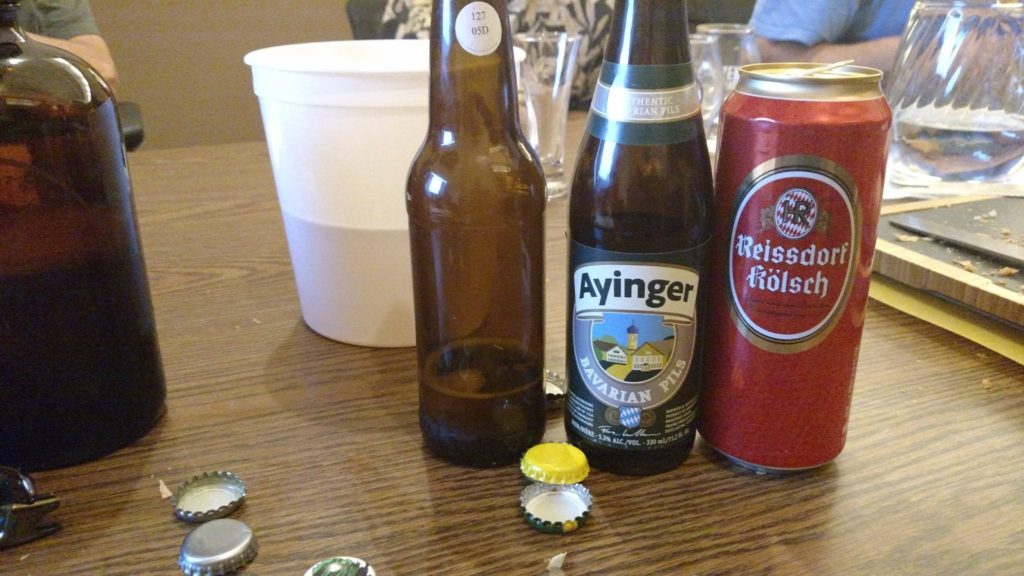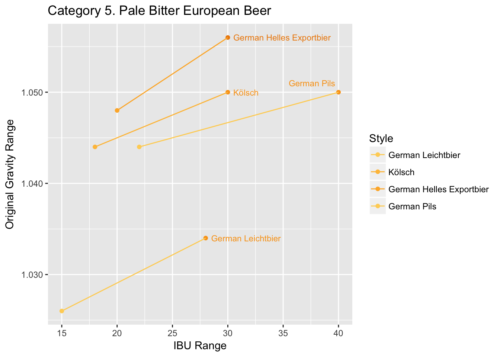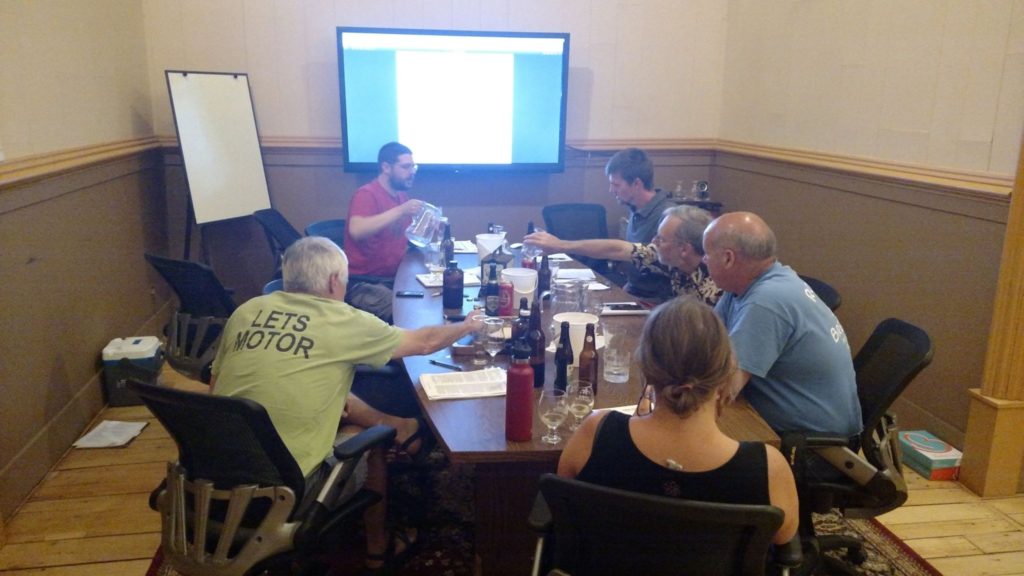BJCP Study Group: Category 5
¶ by Rob FrieselReconvening on cadence, our BJCP study group jumped from Category 2 to Category 5. 1 Right off the bat, our coordinator let us know that these beers turned out to be fairly difficult to find commercial examples of — which was to say, only 2 of the 4 would get the professional treatment that night. Oh well… I guess we’ll all need to keep our eyes peeled for Beck’s Light.
Category 5: Pale Bitter European Beer
Category 5 includes a family of light-colored German-origin beers which, while not exclusively bottom-fermented, are all lagered to some degree. All should be well-attenuated, and while all should be at least moderately bitter and hoppy, balance is important. 2
| 5A. German Leichtbier | 5B. Kölsch | 5C. German Helles Exportbier | 5D. German Pils |
|---|---|---|---|
| 15 – 28 IBU | 18 – 30 IBU | 20 – 30 IBU | 22 – 40 IBU |
| 1.026 – 1.034 O.G. | 1.044 – 1.050 O.G. | 1.048 – 1.056 O.G. | 1.044 – 1.050 O.G. |
| 1.006 – 1.010 F.G. | 1.007 – 1.011 F.G. | 1.010 – 1.015 F.G. | 1.008 – 1.013 F.G. |
| 2.4 – 3.6% ABV | 4.4 – 5.2% ABV | 4.8 – 6.0% ABV | 4.4 – 5.2% ABV |
- 5D. German Pils. Ayinger Bavarian Pils. A pleasant beer that… produced scores all over the map. Scores from the group ranged from 27 to 42, with no real clustering. Literally everyone had a different opinion of this beer. Our discussion turned into a game of whack-a-mole: Did you detect off-flavors? which ones? (or) how could you not? Was your carbonation as poor as mine? Why do you think your head lasted twice as long? Did you not get any alcohol warming sensations? As we circled the drain on this conversation, a couple of questions were raised: (1) Did it matter how much was in the bottle when you poured? and (2) Did it matter how you poured?
- Aside: pouring technique? Based on the previous beer, we went around the table to discuss pouring technique. Was there a “correct” way to pour a taster size sample? Most people were pouring “like normal” and tilting the taster glass before straightening out. One group member chimed in that, when he stewarded a recent competition, the advice he’d gotten from experienced stewards and judges was to simply pour aggressively: “Straight down the middle — don’t be afraid of it.” A few of this decided to adopt this for the rest of the night.
- 5B. Kölsch. Früh Kölsch. Scores were better aligned with one another this time. We discussed the “vinous character” that many detected, and which the style guide claimed was acceptable. Where did it come from? Was it ester-derived? Or was it “sherry-like” and therefore an oxidation effect? How could you tell the difference? And while we were unable to arrive at a rubric for that, we did another sidebar and arrived at a “continuum” for malt character: “cracker” is drier than “bready”, and “biscuit” is sweeter than “bready”. 3
- 5B. Kölsch. Reissdorf Kölsch. We started, but did not complete, a structured evaluation exercise here. (We opted instead to go ahead less formally, and make it more interactive and conversational.) There were a lot of comments within the group about how different this kölsch was from the previous one: different malt character, different mouthfeel, better head retention. There was some disagreement about whether its hop character was more pronounced or not. We also re-visited the “vinous” question from the previous kölsch: ester or oxidation?
- 5B. Kölsch. This time an entrant from the 2017 Greg Noonan Memorial Homebrew Competition (GNMHC). This one was a dumper. Not a ton of diacetyl, but enough to be noticeable — enough to make it a completely different beer.
- Aside: “How are beers grouped for competition?” One of our observant group members pointed out that beer styles from the 2017 GNMHC were lumped together in “categories” that did not exactly align with the Categories as we studied them in our group. “Why is that?” We had some level-setting about what it means to organize a competition, and how you don’t always know what you’re going to get — and also how within a 2015 BJCP category, you might have beer styles that don’t otherwise make sense together (e.g., Category 2). We referred to Appendix A in the 2015 BJCP style guide. We referred to the 2017 GNMHC results, and pointed out how even there it was using a variation on “3. Styles Sorted Using Style Family”, and not that variation explicitly/specifically.
- 5D. German Pils. Again. A homebrew from the 2017 GNMHC this time. This one had a strong fruit ester, but wasn’t bitter enough. It was drinkable, but it was hard to see how it might be categorized as a 5D; perhaps as a “Pre-Prohibition Lager”? perhaps as a Cream Ale?
- 5D. German Pils. Another homebrew from the 2017 GNMHC. This one had an off-lemony start. Crackery malt. Better bitterness when compared to the previous example, and also better carbonation. It was a more pleasing beer to drink, but apparently didn’t score as highly.
- 5D. German Pils. Yet another homebrew from the 2017 GNMHC. Almost unbearably astringent. Comments in the room that said: “Like fresh celery?” A harsh bitterness that no one enjoyed.
- 5C. German Helles Exportbier. Different style but… yet another homebrew from the 2017 GNMHC. Had an aroma like kids vitamins. (Spicy hops commingling with a strong fruity ester, would be my guess.) Also: astringent!
- 5C. German Helles Exportbier. Another homebrew, but this one not from the 2017 GNMHC. Study group impressions… were all over the place. The previously cited “banana ester” was called out by a few people, but I wasn’t getting it personally.
- 5B. Kölsch. This one from a study group member. It had a noticeable fruity ester character which… might have been too strong? (Hard to say for sure.) Considering the age, the floral hop aroma seemed to penetrate. There was a bit of turbidity happening in the glass, but we chalked that up to it being a growler filled off a keg about to kick.
- Guess that style! Erin: “All I’ll tell you about this one is it’s about two years old.” And/but/so we worked through our respective tastings. Guesses included: Scottish Export, Wee Heavy, Dunkel, Dubbel, Belgian Strong…? The right answer: 10C. Weizenbock.
- Side-by-side! Next up, Aaron and myself busted out our respective bottles of the Sorachi Ace Saison. We told the story to everyone about Aaron’s new system, about the formulation, about how the wort was portioned off 5 ways, and how each of us had wort that had been mashed and fermented the same way, but how we’d all pitched with different yeast. About how Aaron’s had rather quickly gotten down to an F.G. of 1.000 (9.8% ABV) and how mine took several more weeks to finish at 1.008 (8.7% ABV). There was agreement around how Aaron’s was stronger, with maybe a harsher alcohol note, and more of the dill character from the Sorachi Ace, as opposed to lemongrass. Mine was a little mellower, though still “too strong” to a few palates, and dry (but not as dry), and was more lemongrass instead of dill. 4 Either way: it was fascinating to do a side-by-side of two beers that only had yeast and fermentation temperature as their differences.
- Palate chaser. “For fun” we finished out the night with another study group member’s first sour beer. A lightly tart pale ale that was pretty refreshing.
Takeaways
- Mineral training? Maybe I’m only speaking for myself here but… there were some comments about which beers maybe had a sulphur character in the aroma or flavor. Then it occurred to me that I might not actually know for sure what that smells/tastes like.
- Pouring technique. Is there a “right” way? And/or a recommended way? Regardless, the whole group should probably be trying to pour using the same, agreed-upon technique. It would seem that that makes a difference in carbonation expression, foam, head retention, and possibly other character factors.
- “Guess that Style” exercises continue to be difficult. I mean… they’re supposed to be challenging. I guess I’m just surprised at just how challenging they’ve been to-date.
- 5B. Kölsch. Deceptively hard to make. Deceptively hard to judge.
- Variation within a given style. It’s interesting how much variation there can be within a given style, especially for competition entries for that style. The variation in 5D. German Pils alone gave many of us pause. How much of this is brewer interpretation? How much of this is untrained palates? How much of this is “simply” how much the beer changed with age between brew day, maturation, packaging, the competition, and when we finally drank them? And how much had to do with the way it was mashed, brewed, fermented, or packaged?
Addendum #1
Some additional thoughts (via a Facebook thread) from Jason, one of our BJCP mentors:
Hope to make it again soon. Very busy summer schedule recently. As far as pouring I concur with the pour vigorously and up the middle. Try to foam up the beer as much as possible since it isn’t getting a real full pour. This will also allow you to really open up the aromatics. So pour hard and smell quickly. This will help you detect some faint, fleeting aromas.
Grouping of style for the competition – The old guidelines were roughly by “family of beer”. In order to go more international (not just U.S.) the 2015 guidelines took on more of a geographic category. This results in very similar beers being in different categories like english porter 13C and american porter 20A. I’ve organized several different styles of competition and grouping can be anything you want. Like this year for Champlain Valley Fair Comp I did these groupings to limit the number of styles/entries.
Category 1: Common American Styles
1B – American Lager
1D – American Wheat Beer
19A – American Amber Ale
19C – American Brown Ale
20A – American Porter
20B – American Stout
18B – American Pale AleCategory 2: Agricultural
25B – Saison (specify Special ingredients, Strength [table, standard, super], Color [Pale, Dark])
29A – Fruit Beer (specify base beer style and fruit)
29B – Fruit and Spice Beer (specify base beer style and fruit/spice/spice/herb/veg)
30A – Spice, Herb, Vegetable Beer (specify base beer style and spice/herb/veg)Category 3: Standard IPA
12C – English IPA
21A – American IPA
22A – Double IPACategory 4: Other IPAs
NonBJCP1 – Fruit IPA (specify fruit, base style of IPA)
NonBJCP2 – Fruit DIPA (specify fruit, base style of DIPA)
NonBJCP3 – New England Style IPA
NonBJCP4 – New England Style DIPA
21B – Specialty IPA (specify type of specialty IPA according to BJCP guidelines)
- Proper Category 3 Czech lagers are hard to come by in the states and Category 4 was scheduled for later in the year so we could get nice, fresh Märzens.[↩]
- It’s a curious artifact quirk of the style, if you ask me. Most of the four style descriptions in Category 5 specifically talk about “mild to moderate” bitterness and/or hop character. Given that the Category is “Pale Bitter European Beer”, one might think more bitterness would be appropriate.[↩]
- I might have thrown in that I also think that “bready” is “yeastier” than both, but the thread was dead by then. And this is to say nothing of how “bread crust” is like “bready” but with more Maillard reaction products… but I digress.[↩]
- One not-to-be-named smartass was comparing mine to Tide detergent but no one else said so and anyway what an odd thing to say?[↩]



Leave a Reply